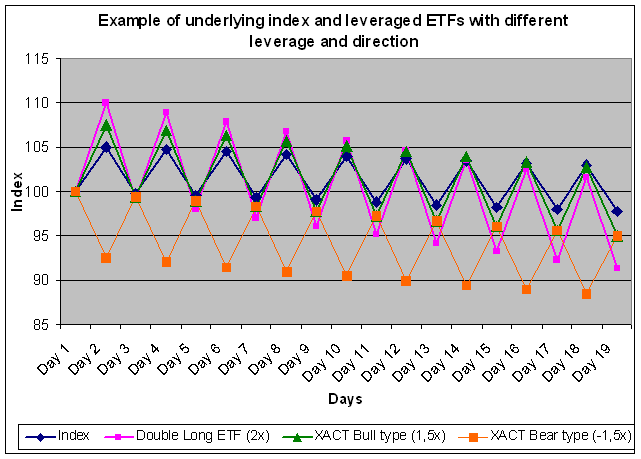Leveraged ETFs
Post on: 4 Июнь, 2015 No Comment

Leveraged ETFs
If you’re new here, you may want to subscribe to my RSS feed. Thanks for visiting!
Not all exchange traded funds (ETFs) are passively managed.
Some use investment strategies that require varying levels of active management.
We will review at a few more ETFs you may encounter when assessing your investing options. These include leveraged, actively managed, wraps, and life-cycle ETFs.
Today we will cover leveraged ETFs.
Leveraged ETFs
Leveraged ETFs use derivative and/or debt instruments to increase the purchasing power of a fund’s portfolio.
The amount of leverage is directly linked to the level of derivatives or debt used.
For example, perhaps you have USD 10,000 to invest in shares of a company trading at USD 100 per share. Ignoring transaction costs, you are able to purchase 100 shares. After one year, the share price rises to USD 150, you sell the 100 shares and net USD 5000 for a 50% return.
But if you leveraged the transaction, your return would be higher.
Say you borrow USD 3000 (30%) at a 5% annual interest rate. You are now able to buy 130 shares, rather than 100. One year later you sell at USD 150 and net USD 6350 after interest expense. You have earned 63.5% % with 30% leverage. Had you been able to borrow 50%, you could buy 150 shares. After a year, had the share price rose to USD 150, you would net USD 7250 after interest. That translates into a 72.5% return at a 50% leverage.
So leverage can enhance ones investment returns.
Of course, leverage is a two-way street. You can amplify your gains by leveraging, but you also can increase your losses. And, as added insult to injury, you also pay a cost on the instruments used to leverage. So be careful.
Ultra ETFs are a special category of leveraged ETFs.
Ultra ETFs attempt to achieve twice the daily return of the target benchmark index. In essence, these ETFs are 100% leveraged.
Investors may like these ETFs as they can get twice the investment for each dollar allocated to the ETF. Perhaps you want to allocate 10% of your capital to equities in emerging markets. However, you only have enough capital available to invest 5% in emerging markets. By investing in an ultra ETF you effectively are investing 10% as the fund’s return should reflect twice the benchmark index.
The greater the leverage, the greater the portfolio volatility. So expect ultra ETFs (or funds with even higher leverage) to be of greater risk than unleveraged (or less leveraged) ETFs.
Also, the returns may not always be twice the benchmark. Tracking error may be a problem. During periods where the markets are flat, ultra ETF returns may not be double. Also, there may be deviations over the longer periods.
Finally, the costs involved with maintaining this investment strategy may impair net returns for investors.
Positives of Leveraged ETFs
The obvious upside with any leverage situation is that the investor gets more bang for the investment dollar. The greater the amount of leverage, the higher the impact.
Many investors and business people have made their fortunes primarily because of leverage use. So I am not going to tell you to avoid using leverage. Just be very aware of the risks and know that greater returns are not guaranteed by leveraging.
Negatives of Leveraged ETFs
The greater that a leveraged product can increase in value, the greater it can also fall.
In our example above, say that the share price instead fell to USD 50 after one year. Unleveraged, you lose USD 5000 or 50%. Leveraged at 30%, you lose USD 6650 or 66.5%. At 50% leverage, you lose USD 7750 or 77.5%. The losses can also accelerate, so be careful.
A big advantage of ETFs is their low expense ratios, relative to other comparable investments.
But, as an ETF leverages, it requires more work by the fund.
Active management is needed to calculate, conduct, monitor, and maintain leverage strategies. There is increased administrative work and filing requirements. Leveraging is not a costless activity. There are costs associated with leverage; interest expense and derivative costs being significant. Finally, there are increased transaction costs associated with initiating and maintaining the leveraged positions.
As work required to leverage an ETF rises, so too does the ETF’s total expense ratio (TER).
By investing in a leveraged ETF, you may negate one of the advantages of ETFs. Be careful when assessing leveraged ETFs. Do not think ETF always equals low cost.
When we reviewed ETF investment costs, I used two common S&P 500 ETFs as examples. Both the iShares S&P 500 Index (IVV) and the Standard & Poor’s Depositary Receipts (SPDR) S&P 500 ETF (SPY) had TERs of 0.09%.
In comparison, let’s check the TERs on two leveraged ETFs that also track the S&P 500 index. The ProShares Ultra S&P500 (SSO) has a TER of 0.92% and the Rydex 2x S&P 500 (RSU) (also 100% leveraged) has a TER of 0.70%.
To leverage through an ETF you are paying a significant cost.
Results for leveraged ETFs are mixed. The first leveraged ETF was created in 1993 (I believe), so they do not have a lengthy track record. In reviewing performance, if you pick the right periods, you will outperform the benchmark. But if you buy during a down cycle, you will likely underperform. No surprise there.
As I mentioned above, there may also be issues with tracking error for funds that attempt to leverage results in specific proportions. You may pay for performance that does not occur.
Not based on any specific empirical evidence, but my instinct says to avoid leveraged ETFs. The listed negatives outweigh the advantage of potentially enhanced returns.
If you do want to leverage, I think it is less costly to leverage directly through margin accounts or bank loans. That is the strategy I would employ.














